Periods of susceptibility for associations between phthalate exposure and preterm birth: Results from a pooled analysis of 16 US cohorts
IF 9.7
1区 环境科学与生态学
Q1 ENVIRONMENTAL SCIENCES
引用次数: 0
Abstract
Background
Phthalate exposure during pregnancy has been associated with preterm birth, but mechanisms of action may depend on the timing of exposure.
Objective
Investigate critical periods of susceptibility during pregnancy for associations between urinary phthalate metabolite concentrations and preterm birth.
Methods
Individual-level data were pooled from 16 US cohorts (N = 6045, n = 539 preterm births). We examined trimester-averaged urinary phthalate metabolite concentrations. Most phthalate metabolites had 2248, 3703, and 3172 observations in the first, second, and third trimesters, respectively. Our primary analysis used logistic regression models with generalized estimating equations (GEE) under a multiple informant approach to estimate trimester-specific odds ratios (ORs) of preterm birth and significant (p < 0.20) heterogeneity in effect estimates by trimester. Adjusted models included interactions between each covariate and trimester.
Results
Differences in trimester-specific associations between phthalate metabolites and preterm birth were most evident for di-2-ethylhexyl phthalate (DEHP) metabolites. For example, an interquartile range increase in mono (2-ethylhexyl) phthalate (MEHP) during the first and second trimesters was associated with ORs of 1.15 (95 % confidence interval [CI]: 0.99, 1.33) and 1.11 (95 % CI: 0.97, 1.28) for preterm birth, respectively, but this association was null in the third trimester (OR = 0.91 [95 % CI: 0.76, 1.09]) (p-heterogeneity = 0.03).
Conclusion
The association of preterm birth with gestational biomarkers of DEHP exposure, but not other phthalate metabolites, differed by the timing of exposure. First and second trimester exposures demonstrated the greatest associations. Our study also highlights methodological considerations for critical periods of susceptibility analyses in pooled studies.
邻苯二甲酸盐暴露与早产之间的易感期:来自16个美国队列的汇总分析结果
背景:怀孕期间邻苯二甲酸盐暴露与早产有关,但作用机制可能取决于暴露的时间。目的探讨妊娠期尿邻苯二甲酸酯代谢物浓度与早产的关系。方法收集来自16个美国队列的个人数据(N = 6045,N = 539例早产儿)。我们检查了妊娠期平均尿邻苯二甲酸盐代谢物浓度。大多数邻苯二甲酸酯代谢物分别在孕早期、中期和晚期有2248、3703和3172个观察值。我们的主要分析使用多信息来源方法下的广义估计方程(GEE)逻辑回归模型来估计早产的妊娠特异性优势比(ORs)和妊娠期效应估计的显著异质性(p <; 0.20)。调整后的模型包括每个协变量与妊娠期之间的相互作用。结果邻苯二甲酸二乙己酯(DEHP)代谢物与早产之间的妊娠特异性关联差异最为明显。例如,在妊娠早期和中期,邻苯二甲酸单(2-乙基己基)酯(MEHP)的四分位数范围内增加与早产的OR分别为1.15(95 %置信区间[CI]: 0.99, 1.33)和1.11(95 % CI: 0.97, 1.28)相关,但这种关联在妊娠晚期为零(OR = 0.91[95 % CI: 0.76, 1.09]) (p异质性 = 0.03)。结论早产与DEHP暴露的妊娠生物标志物的相关性因暴露时间的不同而不同,而与其他邻苯二甲酸酯代谢物无关。妊娠早期和中期暴露表现出最大的关联。我们的研究还强调了在合并研究中敏感性分析关键时期的方法学考虑。
本文章由计算机程序翻译,如有差异,请以英文原文为准。
求助全文
约1分钟内获得全文
求助全文
来源期刊

Environment International
环境科学-环境科学
CiteScore
21.90
自引率
3.40%
发文量
734
审稿时长
2.8 months
期刊介绍:
Environmental Health publishes manuscripts focusing on critical aspects of environmental and occupational medicine, including studies in toxicology and epidemiology, to illuminate the human health implications of exposure to environmental hazards. The journal adopts an open-access model and practices open peer review.
It caters to scientists and practitioners across all environmental science domains, directly or indirectly impacting human health and well-being. With a commitment to enhancing the prevention of environmentally-related health risks, Environmental Health serves as a public health journal for the community and scientists engaged in matters of public health significance concerning the environment.
 求助内容:
求助内容: 应助结果提醒方式:
应助结果提醒方式:


